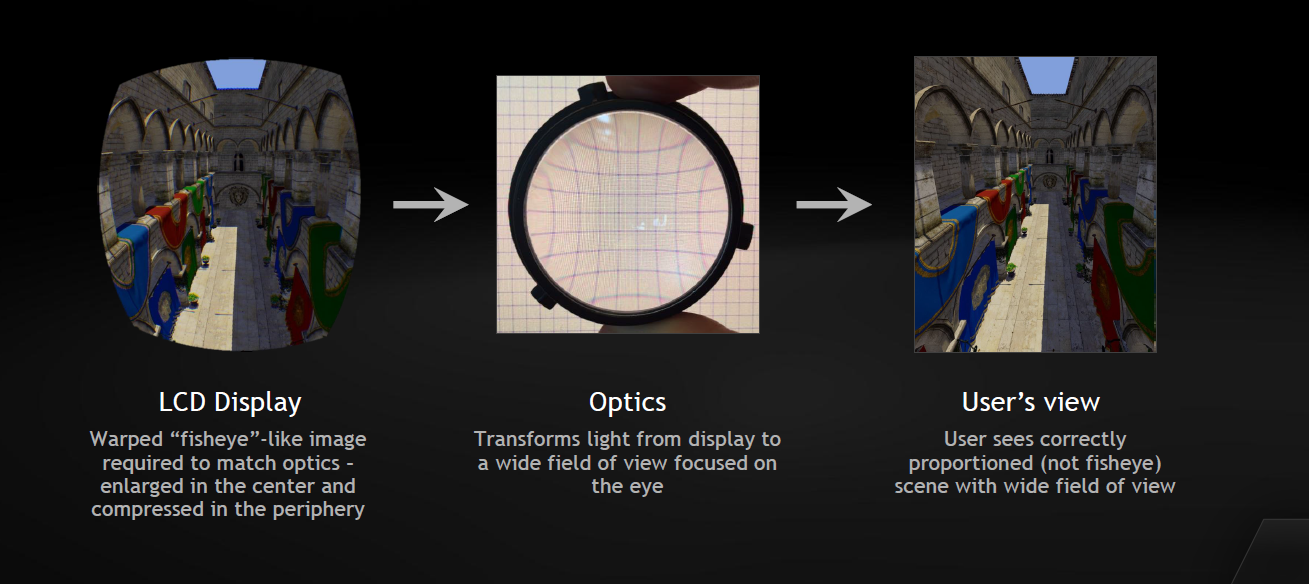Nvidia's Gameworks VR Hits Beta, Provides Two SDKs
While it's obvious that Nvidia's GPUs will play a big role in the upcoming wave of VR HMDs, the company is also developing its own VR software kit entitled "Gameworks VR." When it was revealed prior to E3, it was still in its alpha stages, but just two months later, it is now entering its beta phase of development.
With the shift in development comes two branches for the new SDK — one for game and app developers, and the other primarily for HMD engineers. The game developer SDK contains a few features that we've been fortunate enough to see in person, such as VR SLI, which allows multiple GPUs to update each eye so that the rendering looks smooth without any notable gaps.
However, the more notable part of the kit is the multi-resolution shading, which splits the image into nine sections, or viewports. The center section is still rendered at 1:1 scale, but the other eight viewports have a different resolution due to the warped image. The result is barely noticeable, even in your peripheral vision, but Nvidia said that its pixel shader is doubled with this technique.
On the HMD side, its dev kits are more focused on giving users the feeling of immersion the moment they put on the headset by way of Direct Mode, so that when you put on any VR headset, you don't see the typical Windows desktop. Instead, the driver will recognize the HMD as different from a traditional monitor, showing only the app and games that are compatible with the headset.
There are two other features that focus on the reduction of latency. Context priority allows developers to customize the GPU scheduling, which supports other features such as asynchronous time warp. This in turn reduces latency and helps adjust images in the digital space as players move their heads around, all without the need of rendering every new frame. Front buffer rendering also decreases latency, but goes about it by allowing the GPU to render directly to the front buffer.
The SDK is free for game developers, and the only thing you have to do is sign up for the Gameworks Registered Developer Program. Headset developers, on the other hand, will need to register through the Gameworks VR developer page. Unlike the game developer kit, this beta SDK requires a non-disclosure agreement before use.
Follow Rexly Peñaflorida II @Heirdeux. Follow us @tomshardware, on Facebook and on Google+.
Get Tom's Hardware's best news and in-depth reviews, straight to your inbox.
Rexly Peñaflorida is a freelance writer for Tom's Hardware covering topics such as computer hardware, video games, and general technology news.
-
mesab66 That's an interesting idea about using viewports/making the centre area of the screen as accurate as possible while reducing the accuracy in the outside areas to reduce gfx load.Reply
The central viewport will no doubt depend on the user's head position. I wonder how far off we are in getting the VR headset to track the actual focal point of the eye? If this were possible then this should provide big benefits all round -
1. the 'real' eye point of focus size would be considerably smaller than NVidia's viewport thus gfx processing could be greatly reduced
2. The user would be able to fix his/her head in one position while focussing the eyes on a different display area. Tracking would detect this and alter gfx fidelity/processing to suit the new focal point. This wouldn't be possible with NVidia's viewport method - the whole head would need to rotate in order for the new focal point (viewport) to become rendered in high res.

